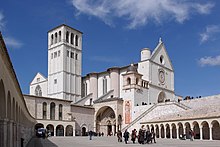Basilica of St. Francis
| Papal Basilica of Saint Francis of Assisi Basilica di San Francesco d'Assisi Basilica Sancti Francisci Assisiensis |
|
|---|---|

|
|
| Basic information | |
| Location | Assisi, Italy |
| Geographic coordinates | 43°04′29″N 12°36′20″E / 43.07472°N 12.60556°ECoordinates: 43°04′29″N 12°36′20″E / 43.07472°N 12.60556°E |
| Affiliation | Roman Catholic |
| Province | Pontifical Delegation for the Basilicas of St. Francis and St. Mary of the Angels in Assisi |
| Country | Italy |
| Year consecrated | 1253 |
| Ecclesiastical or organizational status | Papal minor basilica |
| Heritage designation | 2000 |
| Leadership | Attilio Cardinal Nicora (Pontifical Delegate)· |
| Website | www |
| Architectural description | |
| Architect(s) | Maestro Jacopo Tedesco |
| Architectural type | Church |
| Architectural style | Romanesque, Italian Gothic |
| Groundbreaking | 1228 |
| Specifications | |
| Direction of façade | ESE |
| Length | 80 metres (260 ft) |
| Width | 50 metres (160 ft) |
| Width (nave) | 18 metres (59 ft) |
| Official name: Assisi, the Basilica of San Francesco and Other Franciscan Sites | |
| Type | Cultural |
| Criteria | i, ii, iii, iv, vi |
| Designated | 2000 (24th session) |
| Reference no. | 990 |
| State Party |
|
| Region | Europe and North America |
The Papal Basilica of Saint Francis of Assisi (Italian: Basilica Papale di San Francesco, Latin: Basilica Sancti Francisci Assisiensis) is the mother church of the Roman Catholic Order of Friars Minor Conventual in Assisi, a town of Umbria region in central Italy, where Saint Francis was born and died. The basilica is one of the most important places of Christian pilgrimage in Italy. With its accompanying friary, Sacro Convento, the basilica is a distinctive landmark to those approaching Assisi. It has been a UNESCO World Heritage Site since 2000.
The basilica, which was begun in 1228, is built into the side of a hill and comprises two churches known as the Upper Church and the Lower Church, and a crypt where the remains of the saint are interred. The interior of the Upper Church is an important early example of the Gothic style in Italy. The Upper and Lower Churches are decorated with frescoes by numerous late medieval painters from the Roman and Tuscan schools, and include works by Cimabue, Giotto, Simone Martini, Pietro Lorenzetti and possibly Pietro Cavallini. The range and quality of the works gives the basilica a unique importance in demonstrating the development of Italian art of this period.
...
Wikipedia
